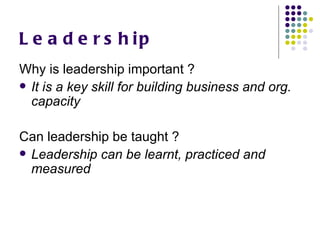
Leadership
- 1. L e a d e r s h ip Why is leadership important ? It is a key skill for building business and org. capacity Can leadership be taught ? Leadership can be learnt, practiced and measured
- 2. Leadership - Definition Leadership is in establishing a goal, setting direction to achieve it and engaging the resources required to accomplish the goal Leadership Actions: Recognising Opportunities & developing achievable plans Challenging yourself & motivating others to deliver breakthru results Championing ideas and people (getting support from Mgmnt.) Using a variety of resources effectively.
- 3. ATTITUDES & CHARACTERISTICS OF LEADERS Winning Attitude: constant striving to achieve better results; not happy with average performance Professionalism: mastery of business fundamentals Committed to Personal Growth: improving own skills; identifying weaknesses and remedying them Integrity: Honesty, Trustworthiness, Commitment, Courage to do the right thing, Ethical Drive: Persistence; Pro-activity; Action Bias High Standards of Excellence: for self and others Spirit of Inquiry: Inquisitive, seeks to understand and identify better solutions
- 4. ATTITUDES & CHARACTERISTICS OF LEADERS (contd.) Holistic Thinking: Sees the big picture along with the parts Values Differences: Open to diff. styles and values each individuals strengths Open & Caring: Good listener, sensitive to others; gives and takes criticism well; genuine; provides honest feedback Practices Situational Leadership: Adapts behaviour to needs of situation and individual without being anything other than genuine self
- 5. Situational Leadership Which style of leadership is better? Can the same style be used with all people? THE BEST LEADERS ARE THOSE THAT ARE ADAPTABLE TO VARIOUS TYPES OF PEOPLE AND SITUATIONS
- 6. SITUATIONAL LEADERSHIP Managers need to adjust their leadership styles to account for subordinates different levels of ability and willingness on different tasks. Managers should reduce “task” behavior (more autonomy and freedom of choice) and increase “relationship” behavior (facilitator rather than supervisor) as reportees level of readiness increases
- 7. SITUATIONAL LEADERSHIP TELLING : Directing the “employee” (what, where, when, how) Used with employees who are not yet able and/or willing to perform the task. High “task” and low “relationship” behavior. SELLING : Selling the employee on the “why” of the task. Invites him/her to “own” or “buy into” task Still directs the task, but decrease in instruction; rewards employee for increase in ability and willingness to do task Used with employees who are more capable/more willing but not yet fully ready
- 8. SITUATIONAL LEADERSHIP PARTCIPATING: Acting as a “colleague” or an “equal” in discussing job with subordinates More collaboration in the “task” aspect but less “relationship” behavior in order to indicate that employee is trusted and self motivating Used with employees who have ability and knowledge to perform the tasks DELEGATING: Setting expectations/vision and then letting them get on with their jobs; stepping in only when they need support of any kind Used with employees who are highly able and willing to direct their own task behaviour
- 9. 3 E’s OF LEADERSHIP NVISION NERGISE NABLE
- 10. ENVISION creating the future enrolment,alignment,commitment FOCUS ON POSSIBILITIES, NOT LIMITATIONS PERSONALLY COMMUNICATE PRIORITIES DEMONSTRATE COMMITMENT FOLLOW UP WORDS WITH ACTIONS
- 11. ENERGISE (Inspiring people to deliver the future) INSPIRING, MOTIVATING REPORTEES SETS GOALS, HIGH STANDARDS, DEFINE R&R PROVIDES CONSISTENT FOCUS SENSE OF URGENCY OPEN COMMUNICATION PERSONALLY DEMONSTRATES ENTHUSIASM DEMONSTRATES CARING; BUILDS TRUST
- 12. ENABLE (Building Capability) BUILDING PEOPLES CAPABILITY / MASTERY PERSONALLY PARTICIPATES IN IMPORTANT IMPROVEMENTS TO SYSTEMS, PROCESSES IDENTIFIES AND ELIMINATES BARRIERS CREATES A POSITIVE WORK ENVIRONMENT RECOGNISES AND REWARDS SUCCESS & CONTRIBUTION OF OTHERS
Editor's Notes
- For Leadership results we need to ensure people at every level of organisation have and use leadership skills. Leadership skills are important for moving up in the organisation. The new appraisal process requires an employee to demonstrate leadership skills to win a promotion.
- Winning Attitude:- Better results mean competitive advantage and “long-term” business success Professionalism:- a) Understanding business drivers (consumer, customer, competition) b) Rules, Procedures and SOP’s c) Uses both facts and intuition Committed to Personal Growth: Honesty & Trustworthiness: admitting mistakes and shortcomings; being honest about performance; Commitment: Say what you mean and Mean what you Say; strong, predictable behaviours and values Drive: Persistence- stick-to-itiveness; Pro-activity-taking the initiative; Action Bias- don’t be part of the problem; be part of the solution
- NO ONE STYLE OF LEADERSHIP IS BETTER OR APPROPRIATE UNDER ALL SITUATIONS. MANAGERS SHOULD EVALUATE INDIVIDUAL SITUATIONS AND ALSO THEIR SUBORDINATES LEVEL OF READINESS BEFORE CHOOSING APPROPRIATE STYLE.
- BEFORE BUILDING CAPABILITY, DEFINE THE CAPABILITY REQUIRED TO DELIVER THE RESULTS IMPROVING SYSTEMS THAT SAVE TIME, MONEY AND EFFORT HOW CAN YOU HELP (SERVICE ATTITUDE AND MENTALITY) RESPECT FOR INDIVIDUALS, DIVERSITY OF THOUGHT AND OPINION, NO HIDDEN AGENDAS REC